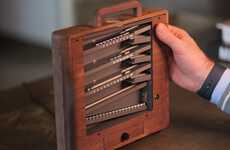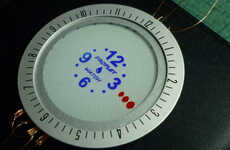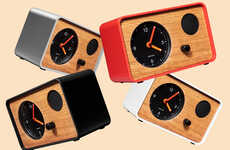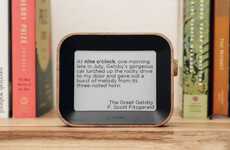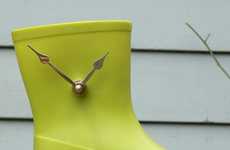
The Citrus Clock
Sandra Winn — November 30, 2008 — Eco
References: annagram.fr & engadget
Love science? Looking for a natural, eco-friendly and semi-old way to tell time? If so, you'll love The Citrus Clock by Anna Gram, a normal childhood science project fashioned into home decor.
The Citrus Clock works the same as powering a clock with a potato. The natural acids substitute the need for a battery when they come in contact with metals like zinc and copper, which creates an electric current.
If you'd like to make your own citrus-powered clock, instead of buying one from someone else, the cost to do so is minimal. Different websites may alter their directions a bit, but the basics are aluminum foil, metal clips, copper wire, and an inexpensive LED battery-powered clock.
Come to think of it, with Christmas vacation just around the corner, you may find making a lemon-powered clock on your own to be a fun, hands-on science experiment to do with your children. Unless you got really creative, however, with aluminum and copper wires all over the place, it would look more like a science project than a present.
The Citrus Clock works the same as powering a clock with a potato. The natural acids substitute the need for a battery when they come in contact with metals like zinc and copper, which creates an electric current.
If you'd like to make your own citrus-powered clock, instead of buying one from someone else, the cost to do so is minimal. Different websites may alter their directions a bit, but the basics are aluminum foil, metal clips, copper wire, and an inexpensive LED battery-powered clock.
Come to think of it, with Christmas vacation just around the corner, you may find making a lemon-powered clock on your own to be a fun, hands-on science experiment to do with your children. Unless you got really creative, however, with aluminum and copper wires all over the place, it would look more like a science project than a present.
Trend Themes
1. Eco-friendly Timekeeping - The Citrus Clock offers an eco-friendly alternative to traditional battery-powered clocks, showcasing the trend of sustainable timekeeping.
2. Science Experiment Home Decor - The Citrus Clock taps into the trend of turning science projects into unique home decor pieces, offering a conversation starter for science enthusiasts.
3. DIY Science Experiments - The popularity of DIY science projects is evident in the interest surrounding making a citrus-powered clock at home.
Industry Implications
1. Home Decor - The Citrus Clock presents opportunities for the home decor industry to incorporate science-themed pieces that appeal to environmentally conscious consumers.
2. Education - The DIY nature of making a citrus-powered clock provides an opportunity for the education industry to develop science experiment kits for children and educational programs.
3. Sustainable Technology - The Citrus Clock highlights the potential for the sustainable technology industry to develop innovative solutions that harness natural resources for powering everyday objects.
3.7
Score
Popularity
Activity
Freshness


